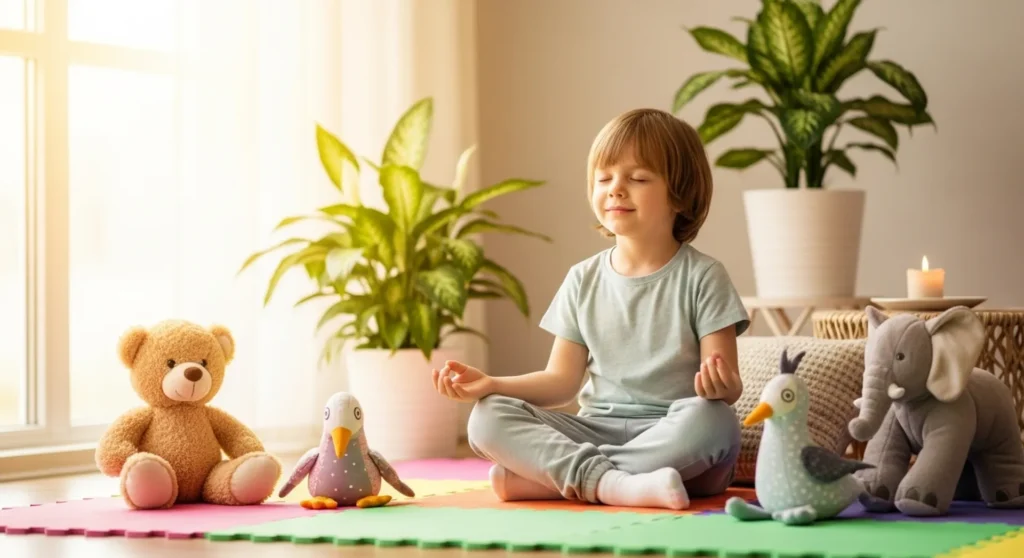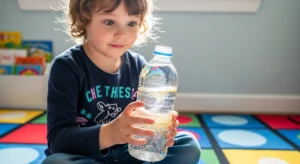In today’s fast-paced world, even our youngest learners face stress, big emotions, and overwhelming moments. As parents, we want to equip our preschoolers with tools to navigate their feelings and develop emotional resilience. That’s where mindfulness and mental wellness practices come in — not as complex meditation techniques, but as simple, age-appropriate activities that help young children find calm, focus, and emotional balance.
Mindfulness for preschoolers isn’t about sitting still for long periods or achieving perfect zen. It’s about teaching young children to notice their feelings, take deep breaths, and find moments of peace in their busy little lives. Research from the American Psychological Association shows that mindfulness practices can significantly improve emotional regulation, attention span, and social skills in young children.
What Is Mindfulness for Young Children?
Mindfulness is the practice of being present in the moment and aware of our thoughts, feelings, and surroundings without judgment. For preschoolers, this translates into simple activities that help them pause, notice, and respond to their emotions rather than react impulsively.
At Preschool With Mommy, we believe that introducing mindfulness early helps children develop essential life skills. When preschoolers learn to recognize their emotions and practice calming techniques, they’re better equipped to handle challenges, build positive relationships, and develop confidence.
Why Mental Wellness Matters in Early Childhood
Mental wellness in preschoolers sets the foundation for lifelong emotional health. Young children who learn coping strategies early are more likely to manage stress effectively as they grow. The National Association for the Education of Young Children emphasizes that social-emotional development is just as important as cognitive development during the preschool years.
Children face more stimulation and change than ever before. From transitioning between activities to managing friendships and handling disappointment, preschoolers need tools to process these experiences. Mindfulness practices provide a gentle way to build these essential skills.
Simple Breathing Exercises for Preschoolers
Breathing exercises are the cornerstone of mindfulness for young children. They’re simple, effective, and can be done anywhere — making them perfect for preschoolers who need quick emotional regulation tools.
Bubble Breathing
This playful technique makes breathing fun and engaging. Ask your child to imagine they’re blowing bubbles. They take a deep breath in through their nose, then slowly breathe out through their mouth as if they’re creating a giant bubble that can’t pop. The goal is to make the exhale long and controlled. Practice this during calm moments so it becomes a familiar tool when emotions run high.
Belly Breathing with a Stuffed Animal
Have your child lie down on their back with their favorite stuffed animal resting on their belly. As they breathe in deeply, the stuffed animal rises. As they breathe out slowly, it falls. This visual and tactile feedback helps children concretely understand deep breathing. It’s especially helpful during our morning huddles or before naptime.
Five-Finger Breathing
This technique combines breathing with gentle touch. Children hold up one hand and use the pointer finger of their other hand to trace up and down each finger. As they trace up a finger, they breathe in. As they trace down, they breathe out. By the time they’ve traced all five fingers, they’ve completed five deep breaths and feel noticeably calmer.
Creating a Calm-Down Corner at Home
A dedicated calm-down space gives preschoolers a safe place to process big emotions. This isn’t a timeout or punishment area — it’s a positive space where children can retreat when they feel overwhelmed, angry, or need a moment to reset.
Essential Elements of a Calm-Down Corner
Start with a cozy, quiet spot in your home. Add soft cushions, a small blanket, and gentle lighting. Include sensory tools like stress balls, textured fabrics, or a glitter calm-down jar. Keep a few favorite books nearby, especially ones about emotions and feelings. Some families include a small mirror so children can check in with their facial expressions and emotions.
Label the space clearly — call it the “Peace Corner,” “Cozy Spot,” or “Calm Zone.” Make it inviting and positive. The ZERO TO THREE organization provides excellent guidance on creating developmentally appropriate calm spaces for young children.
How to Introduce the Calm-Down Corner
Introduce this space during a calm moment, not during a meltdown. Show your child all the tools available and practice using them together. Explain that everyone — even adults — sometimes needs a quiet place to feel better. Model using the space yourself when you feel stressed, showing your child that taking breaks is healthy and normal.
Mindful Activities for Daily Routines
Mindfulness doesn’t require special time or equipment. You can weave these practices into everyday moments, making them a natural part of your preschooler’s day.
Mindful Eating Practice
Turn snack time into a mindfulness lesson. Choose a simple food like a raisin or a piece of fruit. Ask your child to look at it carefully, noticing colors and shapes. Then smell it. Finally, eat it slowly, paying attention to taste and texture. This practice, adapted from traditional mindfulness eating exercises, helps children slow down and be present. It naturally connects with our Superfoods program, where we focus on nutritious eating habits.
Sensory Awareness Walks
Transform your outdoor time into a mindfulness activity. During walks, play “I notice” games. Take turns saying things you notice with each sense — “I notice birds chirping,” “I notice the wind on my face,” “I notice pink flowers.” This simple game teaches children to be present and aware of their surroundings, connecting perfectly with nature-based learning.
Gratitude Practice at Bedtime
Before bed, share three things you’re each grateful for from the day. Keep it simple — “I’m grateful for the yummy pancakes,” “I’m grateful we played together,” “I’m grateful for my cozy bed.” This practice helps children end the day on a positive note and builds appreciation for small joys.
Mindfulness Books and Stories for Preschoolers
Books are powerful tools for teaching mindfulness concepts. Stories help preschoolers understand abstract ideas like emotions, breathing, and awareness through characters and narratives they can relate to.
Some excellent titles include “Breathe Like a Bear” by Kira Willey, which offers simple breathing exercises through playful animal comparisons, and “The Mindful Dragon” by Steve Herman, which teaches emotional awareness through storytelling. “Listening to My Body” by Gabi Garcia helps children identify physical sensations connected to emotions.
Reading these books during quiet times or as part of your learning lab activities reinforces mindfulness concepts in an age-appropriate way. The repetition and discussion that come with reading help solidify these important lessons.
DIY Sensory Tools for Emotional Regulation
Calming Glitter Jars
These magical tools are perfect for helping preschoolers visualize their emotions settling. Fill a clear plastic bottle with water, clear glue, and glitter. When shaken, the glitter swirls frantically — like big emotions. As children watch the glitter slowly settle to the bottom, their breathing naturally slows and their emotions calm. It’s a concrete representation of how feelings can be intense but will eventually settle.
Texture Sensory Bags
Create small bags filled with different textures — smooth rice, bumpy lentils, soft fabric pieces, or squishy play dough. When children feel anxious or overwhelmed, manipulating these textures provides a calming sensory input. The focused attention required to squeeze, touch, and explore the textures naturally redirects their mind from distress to the present moment.
Teaching Emotion Recognition and Management
Mindfulness begins with awareness. Help your preschooler build an emotional vocabulary by naming feelings throughout the day. Use phrases like “I notice you look frustrated” or “You seem really excited right now.” The more children can identify and name their emotions, the better they can manage them.
Create an emotions chart with faces showing different feelings. Let your child check in with the chart throughout the day, pointing to how they feel. This simple practice builds emotional awareness — a key component of mindfulness and mental wellness.
When to Seek Additional Support
While mindfulness practices are beneficial for all children, some preschoolers may need additional support for emotional or behavioral challenges. If your child shows persistent anxiety, difficulty calming down, extreme emotional reactions, or struggles that interfere with daily activities, consider consulting with a pediatrician or child mental health professional.
The American Academy of Child and Adolescent Psychiatry offers resources for parents concerned about their child’s mental health. Early intervention is always beneficial, and mindfulness practices can complement professional support beautifully.
Building Lifelong Wellness Habits
The mindfulness and mental wellness practices you introduce during the preschool years create a foundation for lifelong emotional health. These aren’t just tools for managing difficult moments — they’re skills that help children develop self-awareness, compassion, and resilience.
Start small. Choose one or two practices that resonate with your family and make them part of your routine. As they become habits, add more. Remember that consistency matters more than perfection. Some days will be easier than others, and that’s perfectly normal.
By teaching your preschooler mindfulness now, you’re giving them invaluable tools they’ll carry into elementary school, adolescence, and adulthood. You’re helping them understand that they have the power to calm their own minds and bodies — a truly empowering realization for a young child.
Whether you’re working through our play stations, enjoying outdoor activities, or simply navigating daily routines, mindfulness can enhance every moment. These practices help create the nurturing environment where children feel comfortable, secure, and excited about discovering themselves and the world around them — which is exactly what we strive for at Preschool With Mommy.




